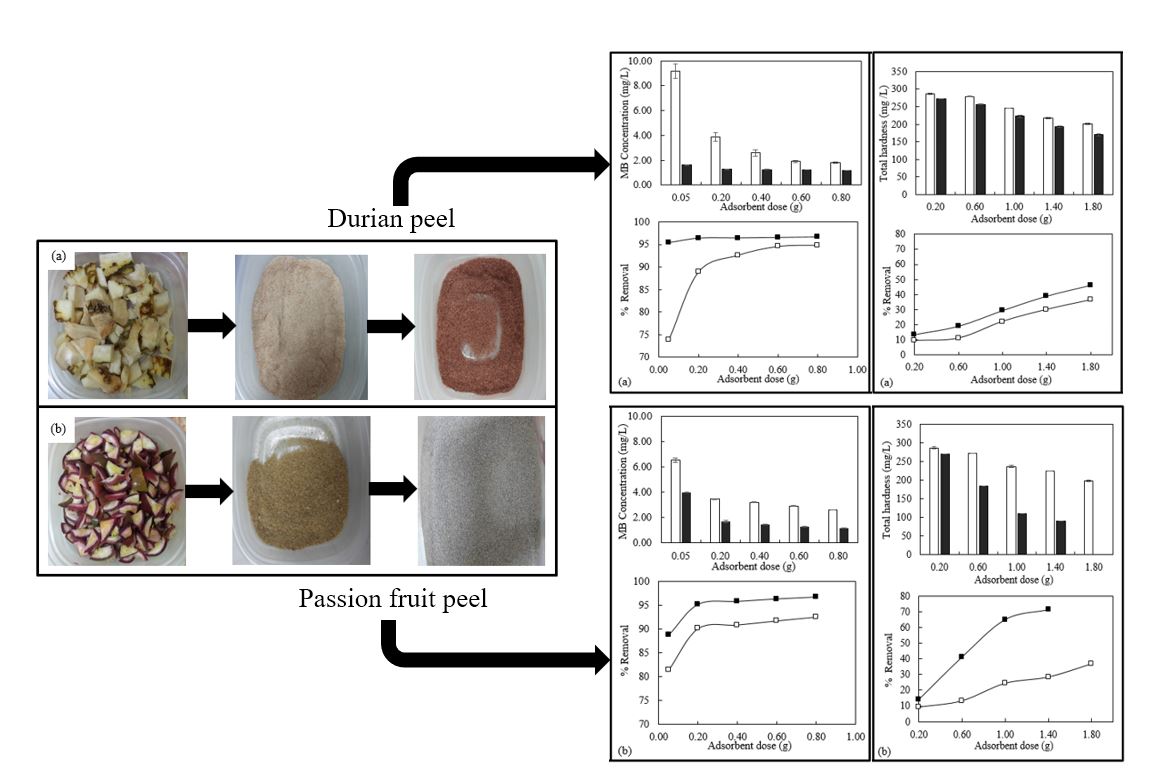Enhanced Removal Efficiency of Methylene Blue and Water Hardness using NaOH-Modified Durian and Passion Fruit Peel Adsorbents
Keywords:
Durian, Passion fruit, Peel, Absorbent, Methylene blue, Water hardnessAbstract
This study evaluated the effectiveness of NaOH-modified adsorbents prepared from durian and passion fruit peels on removal of methylene blue (MB) and water hardness from aqueous solution. The removal efficiencies (adsorbent dose and contact time) of sodium hydroxide (NaOH) modified adsorbents were compared to the raw adsorbents. MB and water hardness removal efficiencies have been greatly enhanced after the durian and passion fruit peels are modified by NaOH. NaOH-modified durian and passion fruit peel adsorbents at 0.05 g dose enhanced the removal of MB from aqueous solution up to 21.56% and 7.30% in comparison to raw adsorbents. This showed that NaOH-modified durian peel is a better adsorbent for MB removal with low dose but able to achieve high removal efficiency. Meanwhile, removal of MB reached maximum at 0.20 g dose using NaOH-modified passion fruit peel adsorbent. NaOH-modified passion fruit peel adsorbent showed better performance in water hardness removal as compared to NaOH-modified durian at 1.40 g dose.
References
B.H. Hameed, H. Hakimi, Utilization of durian (Durio zibethinus Murray) peel as low-cost sorbent for the removal of acid dye from aqueous solutions, Biochemical Engineering Journal. 39 (2008) 338–343. https://doi.org/10.1016/j.bej.2007.10.005.
S.T. Ong, P.S. Keng, S.T. Ooi, Y.T. Hung, S.L. Lee, Utilization of fruits peel as a sorbent for removal of Methylene blue. Civil and Environmental Engineering Faculty Publications, 2012. https://engagedscholarship.csuohio.edu/encee_facpub/101.
C.M. Payus, M.A. Refdin, N.Z. Zahari, A.B. Rimba, A.B., Geetha, M., Saroj, C., Gasparatos, A., Fuku-shi, K., Alvin Olive, P. Durian husk wastes as low-cost adsorbent for physical pollutants removal: groundwater supply, Materials Today: Proceedings (2020) Article in Press. https://doi.org/10.1016/j.matpr.2020.10.006.
Y.H. Tan, C.C. Kerk, C.T. Lee, C.Y. Cheok, The potential of tropical fruit peels as ion exchangers for water hardness removal, IOP Conf. Series: Earth and Environmental Science. 463 (2020) Article ID 012093. https://doi.org/10.1088/1755-1315/463/1/012093.
M. Ngabura, S.A. Hussain, W.A.W.A. Ghani, M.S. Jami, Y.P. Tan, Utilization of renewable durian peels for biosorption of zinc from wastewater, Journal of Environmental Chemical Engineering. 6 (2018) 2528–2539. https://doi.org/10.1016/j.jece.2018.03.052.
Z.M. Lazim, T. Hadibarata, M.H. Puteh, Z. Yusop, R. Wirasnita, N.M. Nor, Utilization of durian peel as potential adsorbent for Bisphenol a removal in aqueous solution. Jurnal Teknologi 74(11) (2015) 109–115. https://doi.org/10.11113/jt.v74.4879.
F.A. Pavan, E.C. Lima, S.L.P. Dias, A.C. Mazzocato, Methylene blue biosorption from aqueous solutions by yellow passion fruit waste, Journal of Hazardous Materials. 150 (2008) 703–712. https://doi.org/10.1016/j.jhazmat.2007.05.023.
G.P. Gerola, N.V. Boas, J. Caetano, C.R.T. Tarley, A.C. Goncalves, D.C. Dragunski, Utilization of passion fruit skin by-product as Lead (II) ion biosorbents, Water, Air, & Soil Pollution. 224 (2013) Article Number 1446. https://doi.org/10.1007/s11270-013-1446-z.
R. Alrozi, N.A. Zamanhuri, M.S. Osman, Removal of methylene blue from aqueous solution by adsorption onto NaOH-treated rambutan peel, in: IEEE Business, Engineering & Industrial Applications Colloquium (BEIAC), Kuala Lumpur, 2012, pp. 92–97. https://doi.org/10.1109/BEIAC.2012.6226113.
B.H. Hameed, Removal of cationic dye from aqueous solution using jackfruit peel as non-conventional low-cost adsorbent, Journal of Hazardous Materials. 162 (2009) 344–350. https://doi.org/10.1016/j.jhazmat.2008.05.045.
K. Tanzim, M.Z. Abedin, Adsorption of methylene blue from aqueous solution by pomelo (citrus max-ima) peel, International Journal of Scientific & Technology Research. 4(12) (2015) 230–232. https://www.ijstr.org/final-print/dec2015/Adsorption-Of-Methylene-Blue-From-Aqueous-Solution-By-Pomelo-citrus-Maxima-Peel.pdf.
C.W. Hu, J. Li, Y. Zhou, M. Li, X. Feng, H. Li, Enhanced removal of Methylene blue from aqueous solution by Pummelo peel pretreated with sodium hydroxide, Journal of Health Science. 55(4) (2009) 619–624. https://doi.org/10.1248/jhs.55.619.
R. Mallampati, X. Li, A. Adin, S. Valiyaveettil, Fruit peels as efficient renewable adsorbents for removal of dissolved heavy metals and dyes from water, ACS Sustainable Chemistry & Engineering. 3(6) (2015) 1117–1124. https://doi.org/10.1021/acssuschemeng.5b00207.
S. Shakoor, A. Nasar, Removal of Methylene blue dye from artificially contaminated water using citrus limetta peel waste as a very low-cost adsorbent, Journal of the Taiwan Institute of Chemical Engineers. 66 (2016) 154–163. https://doi.org/10.1016/j.jtice.2016.06.009.
M.T. Yagub, T.K. Sen, M. Ang, Removal of cationic dye methylene blue (MB) from aqueous solution by ground raw and base modified pinecone powder, Environmental Earth Sciences. 71 (2014) 1507–1519. https://doi.org/10.1007/s12665-013-2555-0.
N. Nasuha, B.H. Hameed, Adsorption of Methylene blue from aqueous solution onto NaOH-modified rejected tea, Chemical Engineering Journal. 166 (2011) 783–786. https://doi.org/10.1016/j.cej.2010.11.012.
S.D. Ashtaputrey, P.D. Ashtaputrey, Preparation, characterization and application of pineapple peel activated carbon as an adsorbent for water hardness removal, Journal of Chemical and Pharmaceutical Research. 8(8) (2016) 1030–1034. https://www.jocpr.com/articles/preparation-characterization-and-application-of-pineapple-peel-activated-carbon-as-an-adsorbent-for-water-hardness-remov.pdf.
D. Mgombezi, V. Rao, S.H. Vuai, S.K. Singh, Investigation on effectiveness of Cactus Materials (Opuntia Spp.) As Adsorbents for Hard Water Treatment, International Journal of Scientific & Technology Research, 6(10) (2017) 239–244. https://www.ijstr.org/final-print/oct2017/An-Investigation-On-Effectiveness-Of-Cactus-Materials-opuntia-Spp-As-Adsorbentsfor-Hard-Water-Treatment.pdf.
H.L. Kharel, R.K. Sharmal, T.P. Kandel, Water hardness removal using wheat straw and rice husk ash properties, Nepal Journal of Science and Technology. 17(1) (2016) 11–16. https://doi.org/10.3126/njst.v17i1.25057.
R. Rostamian, M. Heidarpour, S.F. Mousavi, M. Afyuni, Removal of Calcium and Magnesium by activated carbons produced from agricultural wastes, Advances in Environmental Biology. 8(12) (2014) 202–208. http://www.aensiweb.net/AENSIWEB/aeb/aeb/July%202014/202-208.pdf.
C. Rolence, R.L. Machunda, K.N. Njau, Water hardness removal by coconut shell activated carbon, International Journal of Science, Technology and Society. 2(5) (2014) 97–102. http://www.sciencepublishinggroup.com/journal/paperinfo.aspx?journalid=183&doi=10.11648/j.ijsts.20140205.11.
C.Y. Cheok, N.M. Adzahan, R.A. Rahman, N.H.Z. Abedin, N. Hussain, R. Sulaiman, G.H. Chong, Cur-rent trends of tropical fruit waste utilization, Critical Reviews in Food Science and Nutrition. 58(3) (2018) 335–361. https://doi.org/10.1080/10408398.2016.1176009.
F. Kallel, F. Chaari, F. Bouaziz, F. Bettaieb, R. Ghorbel, S.E. Chaabouni, Sorption and desorption characteristics for the removal of a toxic dye, methylene blue from aqueous solution by a low-cost agricultural by-product, Journal of Molecular Liquids. 219 (2016) 279–288. https://doi.org/10.1016/j.molliq.2016.03.024.
S.R. Geed, K. Samal, A. Tagade, Development of adsorption-biodegradation hybrid process for removal of methylene blue from wastewater, Journal of Environmental Chemical Engineering. 7(6) (2019) Arti-cle 103439. https://doi.org/10.1016/j.jece.2019.103439.
N.C. Feng, X. Guo, S. Liang, Enhanced Cu (II) adsorption by orange peel modified with sodium hydroxide, Transactions of Nonferrous Metals Society of China. 20 (2010) s146–s152. https://doi.org/10.1016/S1003-6326(10)60030-1.

Downloads
Published
How to Cite
Issue
Section
License
Copyright (c) 2021 Progress in Energy and Environment

This work is licensed under a Creative Commons Attribution-NonCommercial 4.0 International License.







